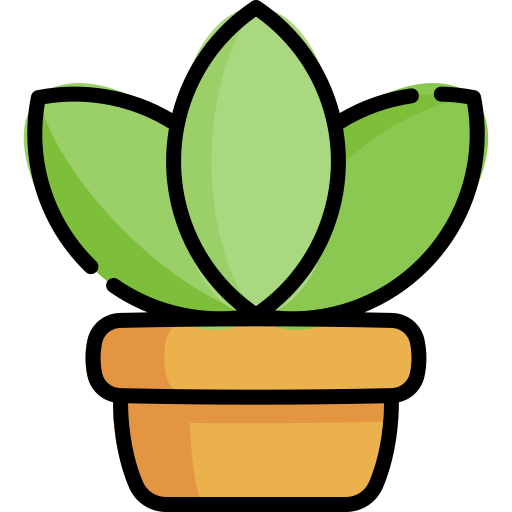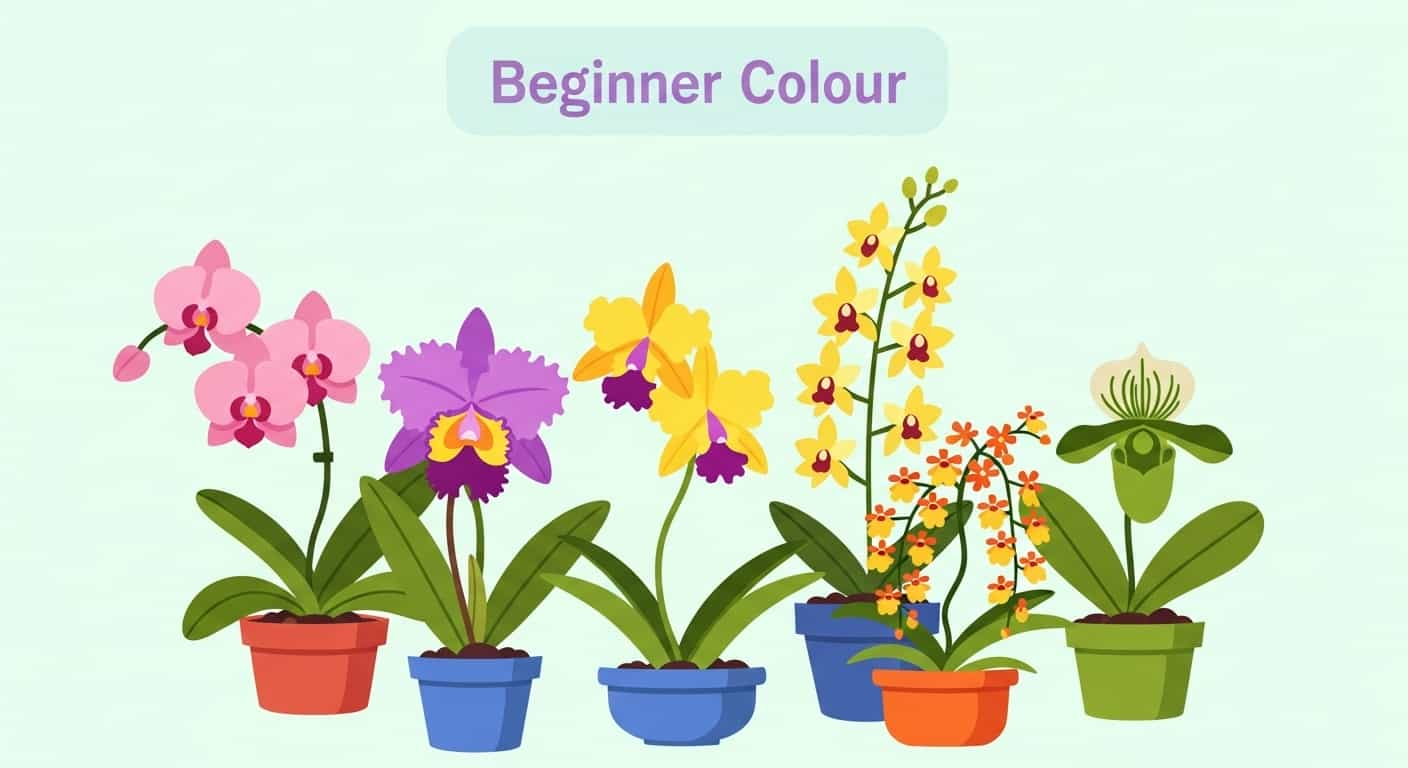Orchids have a reputation for being fussy and difficult to grow. This can make them seem intimidating to new plant enthusiasts. However, many varieties are surprisingly resilient and can thrive with basic care. If you’ve always admired these exotic blooms but have felt hesitant about bringing one home, this guide is for you. We will demystify orchid care and introduce you to the best orchid varieties for beginners (new).
This comprehensive guide will walk you through everything you need to know to start your orchid-growing journey. You’ll learn about the easiest and most rewarding orchids for newcomers, get essential care tips to help them flourish, and discover specific advice for growing these beauties in unique climates like Florida. We’ll explore different types, answer common questions, and help you choose the perfect plant to add a touch of elegance to your home or garden.
Debunking the Myth: Why Orchids Aren’t as Hard as You Think
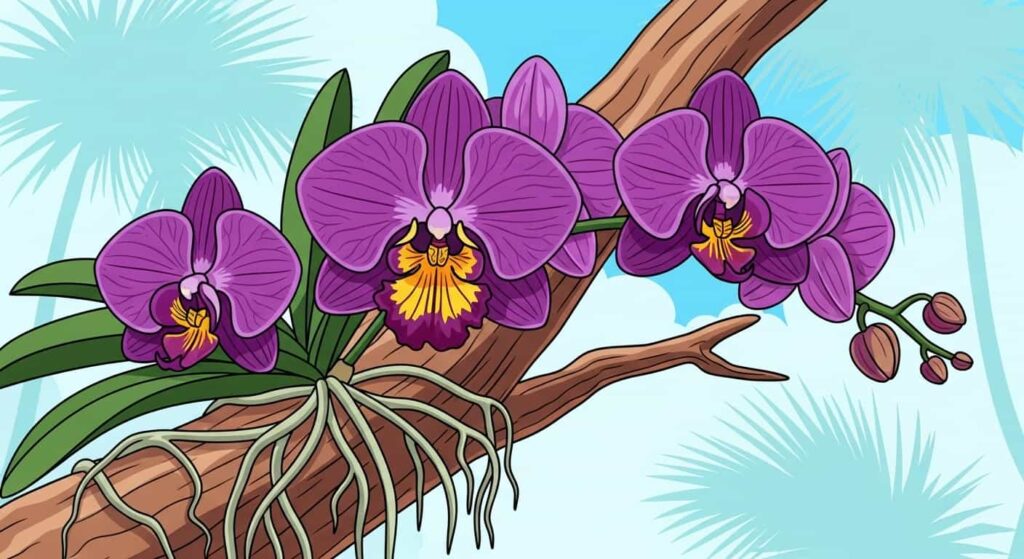
The belief that orchids are delicate divas of the plant world often comes from a misunderstanding of their natural habitat. Unlike typical houseplants that grow in soil, most popular orchids are epiphytes. This means that in the wild, they grow on other plants, like tree trunks and branches, rather than in the ground. Their roots are adapted to cling to bark, absorb moisture from the humid air, and gather nutrients from rain and decaying organic matter.
Once you understand this fundamental difference, orchid care becomes much more straightforward. The key is not to treat them like traditional potted plants. Instead of dense soil, they need a special, airy potting mix that allows their roots to breathe. Their watering needs are also different; they prefer a thorough soaking followed by a period of drying out, mimicking tropical rain cycles.
Many commercially available orchids, especially those recommended for beginners, have been cultivated for decades to be more adaptable to typical home environments. They are more tolerant of variations in humidity, light, and temperature than their wild ancestors. By choosing the right variety and learning a few basic principles, you can successfully grow stunning orchids and enjoy their long-lasting blooms. This guide will answer the question, What are the easiest orchids to grow for beginners? And set you on the path to success.
The Undisputed Champion: Phalaenopsis (Moth Orchids)
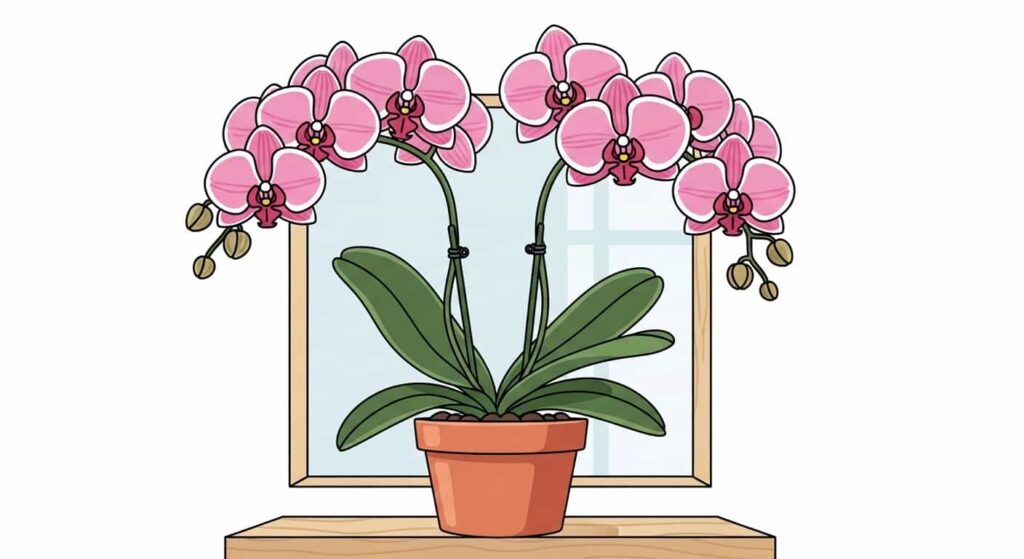
If you ask any seasoned grower, “Which type of orchid is the best for houseplant beginners?” the answer will almost always be the Phalaenopsis. Commonly known as the Moth Orchid because its flowers resemble moths in flight, this variety is the gateway to the world of orchid growing for millions of people. They are the most common house orchid for a reason: they are beautiful, long-blooming, and incredibly forgiving.
Why Phalaenopsis is the Best Orchid for Beginners
The Phalaenopsis orchid is the definitive answer to the question, “What type of orchid is best for beginners?” Here’s why it consistently earns the top spot:
- Adaptable to Indoor Lighting: Phalaenopsis orchids thrive in the same light conditions as many other popular houseplants. They prefer bright, indirect light, similar to what you’d find near an east-facing window or a few feet away from a west- or south-facing window. They do not need direct, harsh sunlight, which can scorch their leaves. This makes them one of the best orchids for indoors.
- Tolerant of Home Temperatures: They are comfortable in the same temperature range that humans enjoy, typically between 65-80°F (18-27°C). They don’t require special temperature drops to initiate blooming, unlike some other orchid types, making them perfectly suited for a stable indoor environment.
- Clear Watering Signals: The roots of a Phalaenopsis are an excellent indicator of its watering needs. When they are silvery-green, it’s time to water. After a good soak, they will turn a vibrant, deep green. This visual cue helps prevent the most common beginner mistake: overwatering.
- Exceptionally Long-Lasting Blooms: One of the most rewarding aspects of growing Phalaenopsis is its incredible flowering period. A single flower spike can produce blooms that last for two to four months, and healthy plants can bloom multiple times a year. This long-lasting display offers a fantastic return on your care investment.
For all these reasons, the Phalaenopsis is widely considered what is the easiest orchid to take care of. And undoubtedly, what is the easiest orchid to keep alive for those new to the hobby? They are the ideal starting point and a perfect choice for easy orchids for beginners indoors.
Phalaenopsis Orchid Care for Beginners
Mastering the care of your Moth Orchid is simple when you focus on the basics.
Light
Place your Phalaenopsis where it will receive bright, indirect light. An east-facing window is perfect. If you only have south or west-facing windows, place the plant a few feet back or use a sheer curtain to diffuse the intense sunlight. Insufficient light is a common reason for a Phalaenopsis failing to rebloom. The leaves should be a bright, olive green. If they are very dark green, the plant needs more light. If they are yellowish or have red edges, it’s getting too much light.
Water
The golden rule of watering orchids is: when in doubt, don’t. Overwatering is the quickest way to kill a Phalaenopsis. Allow the potting medium to become almost completely dry between waterings. A good method is to check the roots; if they are silvery, it’s time to water. Take the plant to the sink and water the potting medium thoroughly for about 15-20 seconds, letting the water run freely out of the drainage holes. Avoid getting water in the crown (where the leaves meet the stem), as this can cause crown rot. If water does get in the crown, gently blot it dry with a paper towel. Never let the pot sit in a saucer of standing water.
Humidity
Phalaenopsis orchids enjoy humidity levels of 40-70%. Most homes are on the lower end of this spectrum, especially in winter. You can increase humidity by placing the orchid on a tray of pebbles filled with water (ensure the pot sits on the pebbles, not in the water) or by using a small humidifier. Misting the leaves in the morning can also help, but avoid doing it late in the day as water sitting on the leaves overnight can encourage fungal growth.
Potting Medium
What is the best orchid mix for Phalaenopsis for beginners? A high-quality, bark-based orchid mix is ideal. This type of mix provides the excellent drainage and airflow that Phalaenopsis roots need to thrive. You can find pre-made Phalaenopsis mixes at most garden centers, which typically contain fir bark, charcoal, and perlite. Repot your orchid every one to two years, or when the bark has broken down and is retaining too much moisture.
Phalaenopsis Orchid Care After Flowering
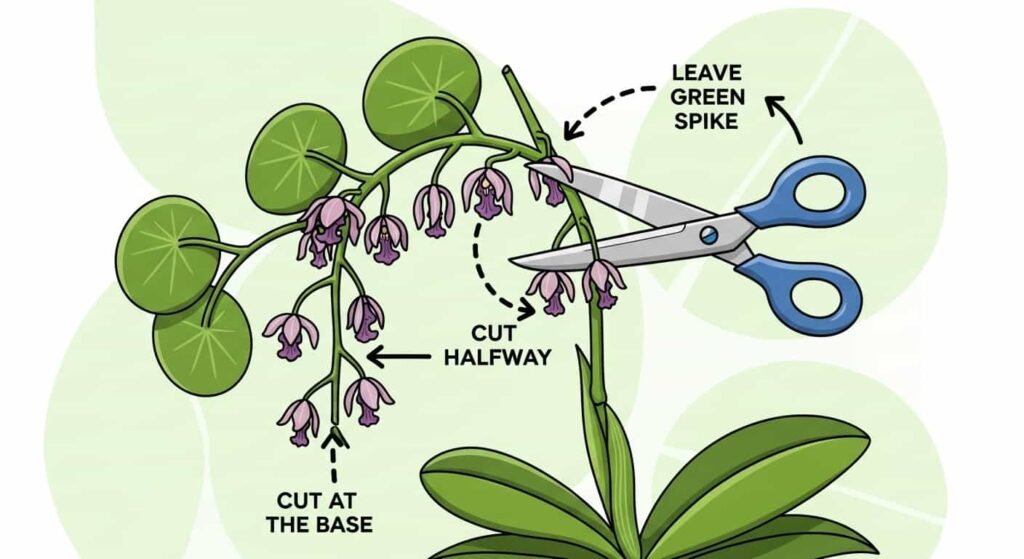
Once the last flower has wilted and fallen off, you have a few options for the flower spike.
- Wait and See: Sometimes the spike will remain green. If it does, you can leave it alone. The plant may produce a secondary spray of flowers from one of the nodes on the existing spike.
- Cut for Reblooming: To encourage a new flush of flowers, locate the small, triangular nodes along the spike. Find a healthy-looking node about halfway down the stem and cut the spike about an inch above it. A new flower-bearing branch may grow from this node.
- Cut it All the Way Back: If the spike turns yellow or brown, it is spent and will not produce more flowers. Cut it off at the base of the plant. This allows the orchid to direct its energy into growing new leaves and roots, which will support a stronger bloom in the next flowering cycle.
After flowering is a great time to repot if needed. Continue with your regular watering and fertilizing schedule, and with good care, your Phalaenopsis should produce a new flower spike within six to nine months.
Getting to Know Your Phalaenopsis
While most Phalaenopsis orchids sold in stores are complex hybrids, understanding the species can be fascinating. Phalaenopsis species identification can be challenging without expert knowledge, but some key features can offer clues. Species like Phalaenopsis amabilis (often called the “queen of Phalaenopsis”) have large, pristine white flowers, while Phalaenopsis schilleriana is known for its beautiful mottled leaves and pink blossoms.
The range of Phalaenopsis orchid colors is truly breathtaking. Modern hybrids are available in a vast spectrum, including pure white, yellow, soft pink, deep fuchsia, spotted, striped, and harlequin patterns. This diversity means you can find a Phalaenopsis to match any decor or personal preference, making them not just a plant but a living piece of art. When you’re searching for the best orchid varieties for beginners, new Phalaenopsis, you’re really looking at this incredible world of color and form.
Beyond the Moth Orchid: Other Easy Orchids for Beginners
While Phalaenopsis are the top pick, they are not the only easy orchids for beginners. Once you feel confident, you might want to try other varieties that are also known for their resilience and beauty. These orchids can help you expand your collection and learn about different growth habits and needs.
Paphiopedilum Orchids (Slipper Orchids)
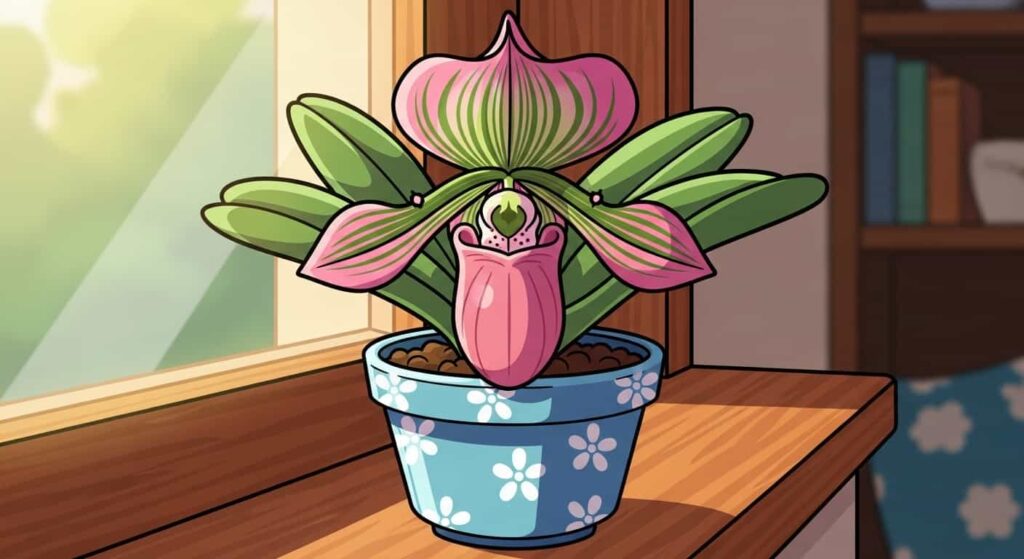
Paphiopedilums, or Slipper Orchids, are named for their unique, pouch-like petal (labellum) that resembles a lady’s slipper. They are among the best orchids for indoors for beginners because they share similar light requirements with Phalaenopsis.
- Why They’re Easy: They thrive in low to medium indirect light, making them perfect for homes with less-than-ideal sun exposure. They are also terrestrial orchids, meaning they grow in the soil-like humus of the forest floor, so their care can feel a bit more intuitive to traditional gardeners.
- Care Tips: Use a fine-grade orchid mix and keep the medium consistently moist but not soggy. Unlike Phalaenopsis, you shouldn’t let them dry out completely between waterings. Their flowers are incredibly unique and can last for several months. Mottled-leaf varieties generally prefer warmer temperatures, while solid green-leaf types enjoy slightly cooler conditions.
Cattleya Orchids (The Corsage Orchid)
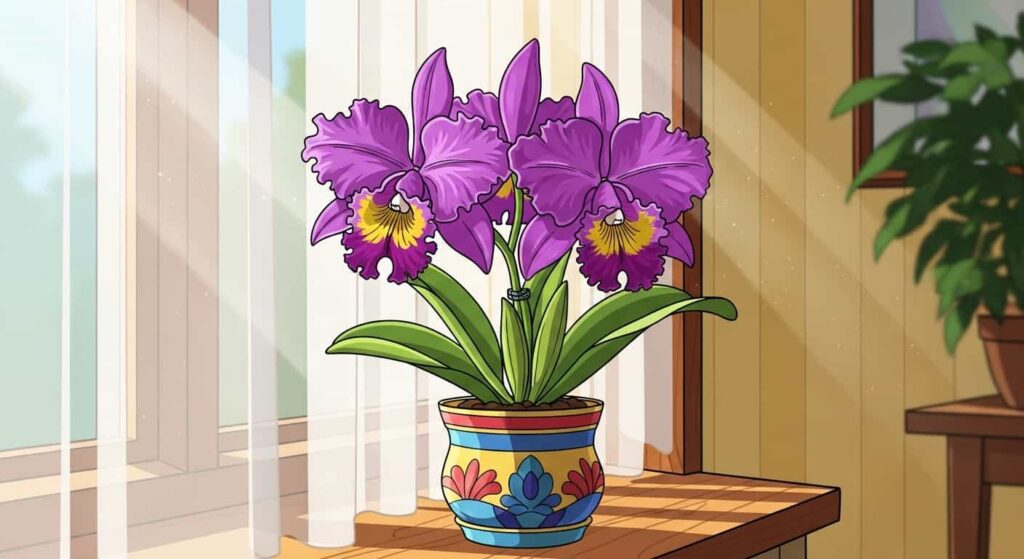
Known as the “Queen of Orchids,” Cattleyas are famous for their large, fragrant, and incredibly showy flowers—the kind traditionally used in corsages. While some species can be demanding, many modern Cattleya hybrids are quite robust.
- Why They’re Easy (with a catch): “Compact” or “mini” Cattleya hybrids are a great choice for beginners. They are more manageable in size and more forgiving of care inconsistencies. The main difference from Phalaenopsis is their need for more light.
- Care Tips: Cattleyas need bright, filtered light, more than a Phalaenopsis, but still not direct midday sun. A lightly shaded south-facing window is a good spot. They have pseudobulbs (thickened stems) that store water, so it’s crucial to let them dry out completely between waterings. Their spectacular, often fragrant blooms are a stunning reward.
Dendrobium Orchids
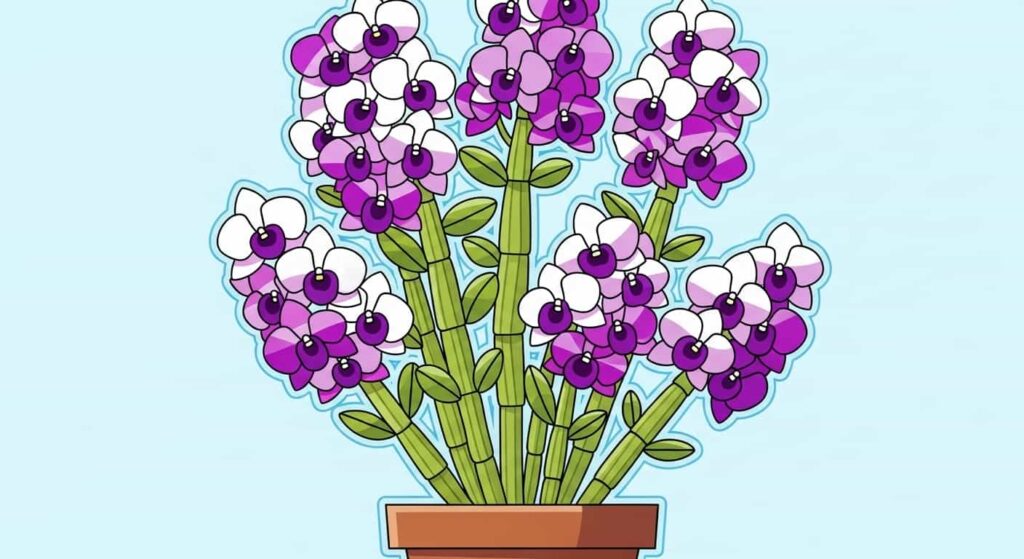
The Dendrobium genus is one of the largest and most diverse in the orchid family. This means their care requirements can vary widely, but certain types are very well-suited for beginners. The “hard-caned” or “Phalaenopsis-type” Dendrobiums are an excellent choice.
- Why They’re Easy: These Dendrobiums have care needs very similar to Phalaenopsis orchids, enjoying warm temperatures and bright, indirect light. They produce tall sprays of long-lasting flowers that look somewhat like Phalaenopsis blooms but grow in clusters along the cane.
- Care Tips: They grow from tall canes and prefer to be somewhat pot-bound. Water thoroughly when the potting mix is dry. During the growing season (spring and summer), water and fertilize regularly. Many Dendrobiums need a slightly drier, cooler rest period in the winter to encourage blooming. How to differentiate between dendrobium and phalaenopsis? The most obvious difference is their growth habit. Phalaenopsis grows from a central crown (monopodial), while Dendrobiums grow from upright canes or pseudobulbs (sympodial).
Oncidium Orchids (Dancing Lady Orchids)
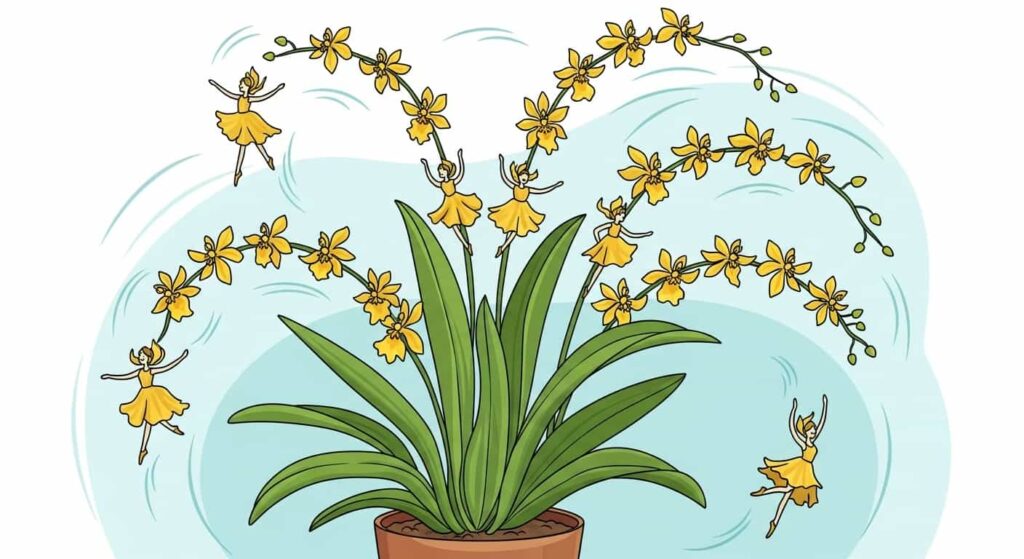
Oncidiums are famous for their abundant sprays of small, delicate flowers, often in vibrant shades of yellow, which gives them the nickname “Dancing Lady.” Many hybrids are easy to grow and put on a spectacular show when in bloom.
- Why They’re Easy: Oncidium alliance hybrids (crosses with related genera like Brassia and Miltonia) are generally hardy and adaptable. They are vigorous growers and can flower multiple times a year.
- Care Tips: They prefer bright, indirect light, similar to Cattleyas. They have thin pseudobulbs that can become wrinkled if the plant is too dry, providing a helpful visual cue. Water when the medium is just approaching dryness. Their profusion of cheerful flowers makes them one of the most rewarding easy orchids for beginners in pots.
Orchid Growing in the Sunshine State: Florida-Specific Insights
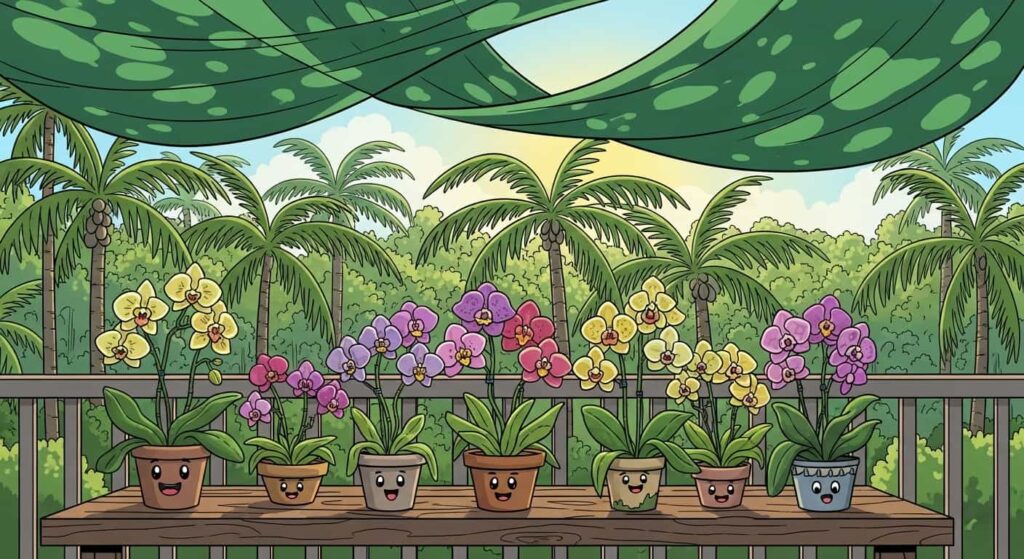
Florida’s warm, humid climate seems like an orchid paradise, and in many ways, it is. The state’s environment allows for a wider range of growing possibilities, including outdoor cultivation. If you’re wondering, “Can orchids thrive in Florida?” the answer is a resounding yes! However, there are some specific considerations for success. This makes it a unique place for those searching for the best orchid varieties for beginners in New Florida.
How to Grow Orchids in Florida for Beginners
The key to success in Florida is choosing the right orchid for the right location and understanding the state’s distinct seasons: the hot, wet summer and the cooler, drier winter.
Growing Orchids on Your Florida Lanai
The lanai (a covered patio or porch) is the perfect microclimate for growing orchids in Florida. It provides protection from the intense midday sun and heavy downpours while still offering the bright light and air circulation that orchids love.
- Light: A lanai with a northern or eastern exposure is ideal. If your lanai faces south or west, you may need to use shade cloth or place plants strategically to avoid sunburn.
- Watering: During the rainy summer months, you may not need to water your lanai-grown orchids at all. Check them regularly and only water if the potting medium is dry. In the drier winter and spring, you’ll need to water more frequently.
- Varieties: Phalaenopsis, Cattleya, and Dendrobium hybrids all do exceptionally well. Vandas, with their spectacular hanging roots, are also a fantastic choice for a Florida lanai, as they adore the high humidity.
Easiest Orchids to Grow Outdoors
For those wanting to integrate orchids directly into their landscape, some varieties are tough enough to handle Florida’s outdoor conditions. Many encyclia, schomburgkia, and certain Dendrobium and Cattleya species can be mounted on trees. This mimics their natural epiphytic habitat. The tree’s canopy provides the perfect filtered light, and the bark gives its roots a surface to cling to. These can be considered some of the easiest orchids to grow outdoors in the right climate.
Florida Native Orchids
Florida is home to a beautiful array of native orchids. While collecting them from the wild is illegal and harmful to the ecosystem, many are available from reputable nurseries specializing in native plants. Learning about them can deepen your appreciation for the local flora.
- Florida Native Orchids Identification: Some notable species include the Butterfly Orchid (Encyclia tampensis), which is very common and produces small, fragrant flowers, and the Ghost Orchid (Dendrophylax lindenii), a famous and leafless epiphyte.
- Native Florida Ground Orchids: While most orchids are epiphytes, Florida also has terrestrial types. The Grass Pink (Calopogon tuberosus) and various ladies’ tresses (Spiranthes species) are beautiful examples of native Florida ground orchids that grow in specific habitats like prairies and pinelands.
For a beginner in Florida, starting with robust hybrids like the best orchid varieties for beginners, new Florida Phalaenopsis is still the best strategy. Once you gain experience, you can explore the rewarding challenge of cultivating native species or more exotic tropicals that thrive in the state’s unique climate.
Essential Orchid Care: Avoiding Common Beginner Mistakes
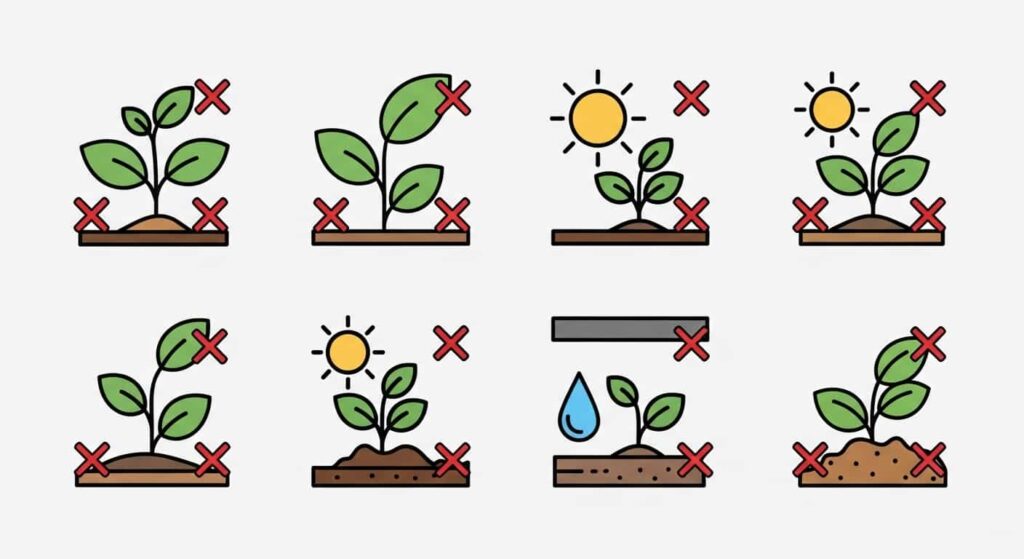
Learning what not to do is just as important as learning what to do. Many new orchid owners make a few common mistakes that can easily be avoided. Answering the question, “How to keep an orchid alive for dummies?” starts with dodging these simple pitfalls.
What Not to Do to Orchids
- Don’t Overwater: This is the number one killer of orchids. Roots that are constantly wet will rot, suffocating the plant. Always let the potting mix dry out appropriately for the specific orchid type.
- Don’t Use Regular Potting Soil: Standard soil is too dense. It will compact around the roots, cut off air circulation, and lead to root rot. Only use a specialty orchid mix.
- Don’t Use a Pot Without Drainage: Orchids must have excellent drainage. Water needs to flow freely through the pot. Decorative pots without holes (cachepots) are fine for display, but the orchid should be in a separate plastic liner pot with ample drainage that can be removed for watering.
- Don’t Expose to Direct Sun: The leaves of most beginner-friendly orchids will scorch in direct, intense sunlight. Bright, but filtered, light is the goal.
- Don’t Fertilize a Dry Plant: Never apply fertilizer to a dry orchid, as this can burn the roots. Water the plant thoroughly first, then apply a diluted fertilizer solution.
Answering Your Top Care Questions
Do Orchids Prefer Shallow or Deep Pots?
Orchids generally prefer pots that are just large enough to accommodate their root system, with about an inch of growing room. They like to be snug in their pots. A pot that is too large will hold excess moisture and take too long to dry out, increasing the risk of root rot. Therefore, whether orchids prefer shallow or deep pots is less important than the pot’s width. Choose a pot that is proportional to the root mass, which often means a relatively shallow pot is sufficient.
Can I Grow My Orchids in Just Water?
The short answer is generally no, at least not for long-term health. While some people experiment with “full water culture,” it’s a very advanced technique that is difficult to get right. Epiphytic orchids are not aquatic plants. Their roots are adapted for air circulation and cycles of wet and dry. Constant submersion in water deprives them of oxygen and will almost always lead to root rot. A proper, well-draining orchid mix is the best and safest method for beginners.
What’s the Biggest Mistake When Repotting Orchids?
The single biggest mistake when repotting orchids is choosing a pot that is far too large. New growers often think they are giving their plant “room to grow,” but in reality, they are creating a swampy environment that the roots cannot handle. The new pot should only be 1-2 inches larger in diameter than the old one. Another mistake is repotting at the wrong time. The best time to repot is just after flowering is complete, when the plant is beginning to produce new root or leaf growth.
Expanding Your Orchid Knowledge: Identification and Types
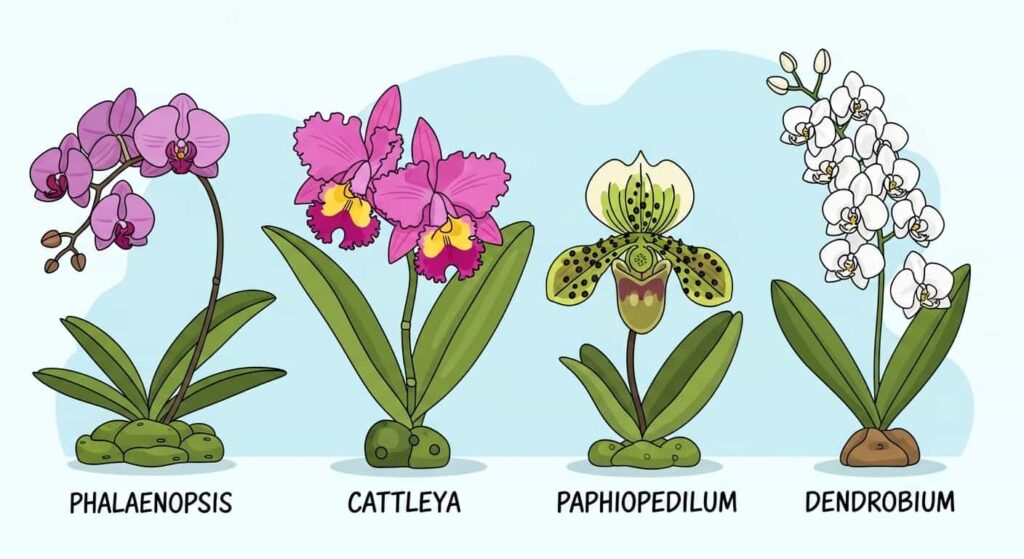
As your interest grows, you’ll naturally want to learn more about the vast and diverse orchid family. With over 25,000 species and hundreds of thousands of registered hybrids, it’s a lifelong learning journey.
How Do I Identify What Kind of Orchid I Have?
For beginners, identifying an orchid usually starts with observing its key features:
- Flowers: The shape, size, color, and arrangement of the flowers are the most obvious clues. A pouch-like lip points to Paphiopedilum. A large, frilly lip suggests a Cattleya. A spray of moth-like blooms is likely a Phalaenopsis.
- Leaves: The foliage also provides hints. Types of orchids by leaves can be a useful category. Phalaenopsis have broad, floppy, low-growing leaves. Cattleyas have tougher, more elongated leaves growing from the top of a pseudobulb. Some Paphiopedilums have distinctive mottled patterns on their leaves. An orchid with long leaves could be many types, but if they are very tough and grow from a pseudobulb, it might be a Cymbidium.
- Growth Habit: Does it grow from a single point (monopodial, like Phalaenopsis) or does it spread sideways with new growths (sympodial, like Cattleya and Dendrobium)? Does it have thickened stems for water storage (pseudobulbs)?
Using these clues, you can often narrow it down to a specific genus. From there, online resources, orchid societies, and guidebooks can help you get closer to a specific species or hybrid name.
Exploring the Diversity: 24 Types of Orchids and Beyond

While we’ve focused on beginner-friendly options, the orchid world is immense. Exploring a list of 24 types of orchids or more reveals an incredible variety:
- Vanda: Known for their large, stunning flowers and love of high humidity. They are often grown in hanging baskets with no potting medium at all.
- Cymbidium: These are often large plants known for their long, graceful sprays of waxy, long-lasting flowers. They prefer cooler temperatures than most tropical orchids.
- Miltoniopsis (Pansy Orchid): Known for their flat-faced, fragrant flowers that resemble pansies. They enjoy cooler temperatures and consistent moisture.
- Rare Types of Orchids: For the collector, there are countless rare types of orchids, from the elusive Ghost Orchid to the black-flowered Fredclarkeara After Dark.
Comparing Common Genera
Understanding the differences between the most common types is a key step in developing your expertise.
- What is the difference between a Cymbidium orchid and a Phalaenopsis orchid? The differences are significant. Phalaenopsis are warm-growing, low-light epiphytes with no pseudobulbs. Cymbidiums are typically larger, cool-growing orchids with prominent pseudobulbs and long, grass-like leaves that require much brighter light to bloom well.
- As mentioned earlier, differentiating between Dendrobium and Phalaenopsis is easiest by looking at the growth habit. Dendrobiums grow from upright canes (a sympodial habit), while Phalaenopsis grow from a central crown with leaves emerging from the top (a monopodial habit).
Famous, Fun, and Fascinating Orchid Facts
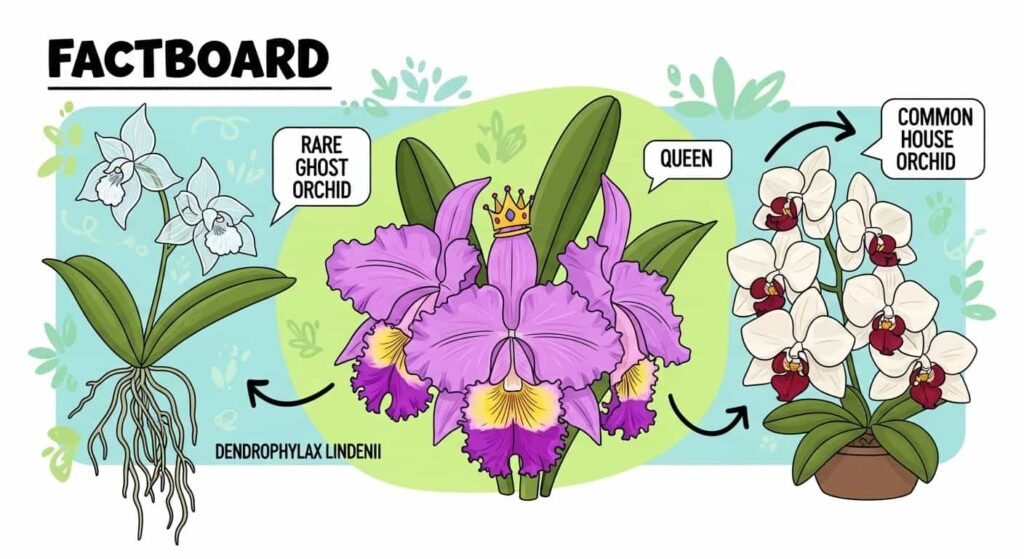
To round out your introduction to this captivating plant family, here are the answers to some common questions about notable orchids.
- What is the queen of all orchids? This title is often given to the Cattleya genus. Their massive, fragrant, and breathtakingly beautiful flowers have made them a symbol of luxury and exotic beauty for over a century.
- What is the most beautiful orchid in the world? Beauty is subjective, but many would nominate the Ghost Orchid (Dendrophylax lindenii) for its ethereal, leafless appearance, or perhaps one of the incredibly vibrant and complex Vanda hybrids.
- What is the prettiest orchid? This is a personal choice! For some, it’s the classic elegance of a white Phalaenopsis. For others, it’s the quirky charm of a Paphiopedilum or the dazzling color of a Cattleya. The “prettiest” orchid is the one that captures your heart.
- What is the most common house orchid? Without a doubt, the Phalaenopsis orchid is the most common and widely available houseplant orchid in the world.
- What is the hardest orchid to take care of? This is a debated topic among experts, but many agree that some of the leafless, high-altitude, or highly specialized species are exceptionally challenging in cultivation. The Ghost Orchid is notoriously difficult, requiring perfect humidity, airflow, and a specific symbiotic fungus on its host tree to survive.
Your Orchid Journey Begins
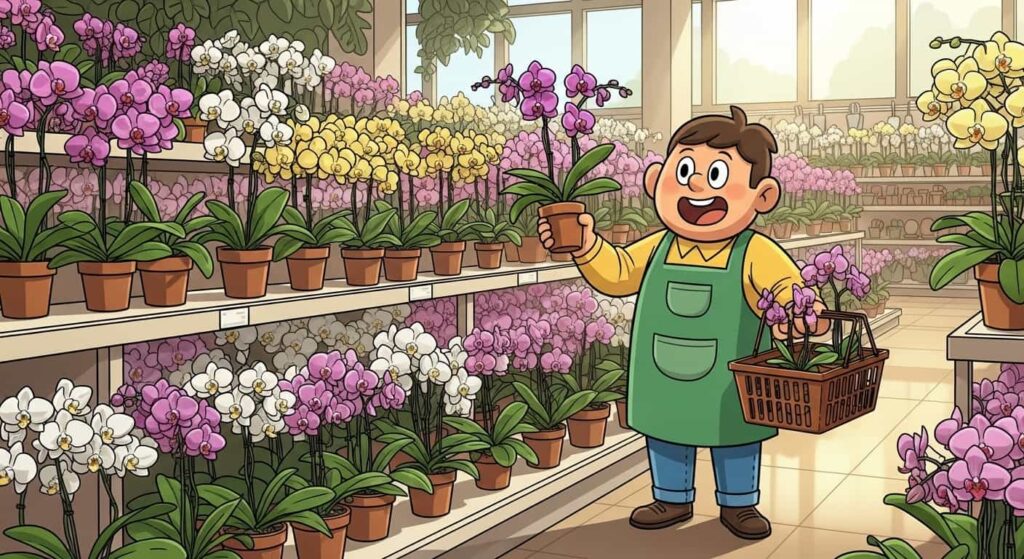
Starting with orchids doesn’t have to be a journey filled with anxiety. By choosing one of the many easy orchids for beginners, like a beautiful and forgiving Phalaenopsis, you set yourself up for a rewarding experience. These plants offer a spectacular display of beauty that can last for months, bringing a touch of the exotic to your home.
Remember the basics: provide bright, indirect light; water only when the medium is dry; use a proper, airy orchid mix; and select a pot that is just big enough for the roots. By avoiding a few common pitfalls, you will discover that orchids are not the fragile flowers they are often made out to be. They are resilient, fascinating, and deeply rewarding to grow.
Now that you are armed with this knowledge, you are ready to visit your local nursery or garden center. Go ahead and choose the orchid that speaks to you. Your adventure into the magnificent world of orchids is just beginning.
